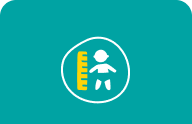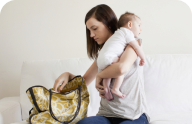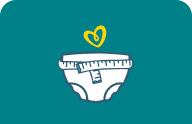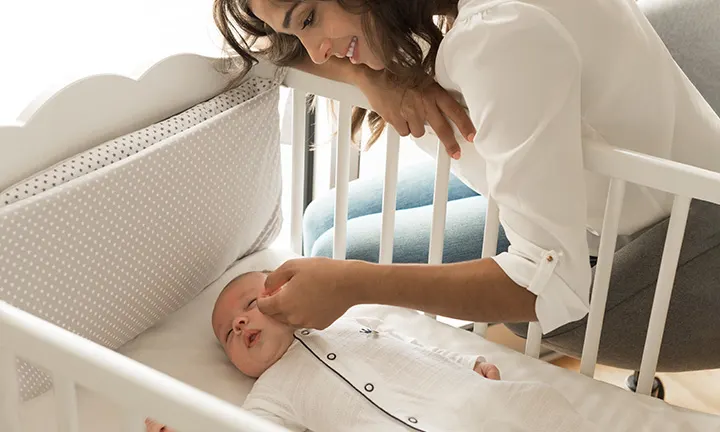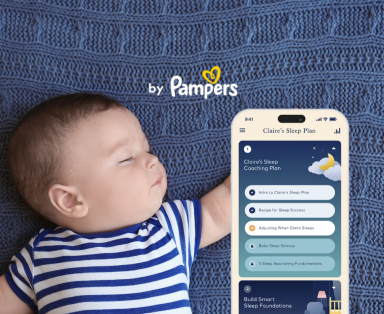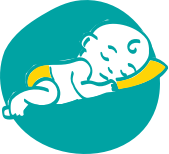Safe Sleep for Babies: A Practical Guide
IN THIS ARTICLE
When it comes to safe sleep for babies, there are a number of important guidelines to know about and follow—and some important questions to answer, too! You’re not the only parent wondering if safe co-sleeping is possible, what should newborns sleep in at night, and when to move your baby to their own room. We’ve got the answers to all these questions and many more, plus a list of additional tips to help promote safe sleep for your sweet baby.
The Importance of Safe Sleep Habits
Practicing safe sleep habits will help guard your baby against dangers that can happen while snoozing, whether at naptime or during nighttime sleep. Safe sleeping involves taking precautions to avoid potential hazards such as falls, choking, suffocation, and SIDS (Sudden Infant Death Syndrome). Following safe sleep strategies for babies can help you prevent these dangerous outcomes. Keep reading to pick up insights and tips on the best practices for safe sleep in the newborn stage and as your little one grows older.
The Most Important Safety Tip: Put Your Baby to Sleep on Their Back
Every time you put your little one down to sleep, place them on their back. Do this at naptime, bedtime, and in the middle of the night after you are finished feeding or changing your baby. As a general rule, your baby should sleep on their back until their first birthday, though your baby may learn to roll over both ways before then. Back sleeping is the safest and best sleep position for newborns and babies, as it helps reduce the risk of SIDS and accidental suffocation.
Can Newborns Sleep on Their Sides or Stomachs?
Babies will inevitably move when they snooze, so as you check on your little one throughout the night, you may notice that they’ve rolled onto their side or tummy. When babies sleep on their stomach or side, it increases the risk of choking, suffocation, and SIDS. If you notice your newborn or baby roll onto their side or stomach in their sleep, just gently reposition them onto their back. When is it safe for babies to sleep on their stomachs? At some point, your little one will reach an exciting milestone: rolling over! Once your baby has learned how to roll over both ways on their own (typically around 5 or 6 months), it's not necessary to reposition a newborn during sleep if they turn onto their side or stomach.
Sleeping in a Crib: Why It’s Safest for Your Baby
For those wondering what do newborns sleep in, safe sleeping for newborns and older babies means sleeping in a crib, bassinet, or a play yard. If you start with a bassinet and are wondering when to move your baby to a crib, a few weeks or a month after birth is likely when they’ll need a larger sleeping area, a. k. a. a crib.
So, the answer to the question can newborns sleep in a crib is yes, of course! Many parents choose to use a crib from the start, and some Pampers Parents prefer baby cribs that grow with their child by being converted to a bed later on.
Unsafe Places for Babies to Sleep
Following the ABCs of safe sleep—which means your baby sleeps Alone, on their Back, and in a Crib—includes knowing where your child shouldn’t sleep. Is it safe for a baby to sleep in a car seat? What about on the couch?
Infants and babies of any age should never sleep in your bed or on a couch, sofa, or armchair. These can be dangerous because your baby could roll off, get stuck in a gap, or suffocate on a pillow, for example. Babies also shouldn’t sleep in a carrier, sling, car seat, or stroller for the same reasons. If your little one falls asleep in one of these, move them to their crib as soon as possible.
Crib Safety
Safe sleep for babies has a lot to do with crib safety. When you select a crib for your little one, check that it meets the latest safety standards. Brand-new cribs purchased in the United States should meet all applicable standards. Some examples of these standards and other aspects of crib safety include the following:
Cribs must not have a drop-side rail, which, when lowered, can lead to your baby falling out.
Slats in the crib should be no more than 2 3/8 inches apart so your baby’s head can’t become trapped between them.
Headboards and footboards should not have any cutouts, which could also entrap your baby’s head.
The corner posts should be flush with the end panels so loose clothing on your baby can’t become snagged and pose a choking hazard. Note that vintage or antique cribs (such as hand-me-downs from family) might have decorative finials that could also snag clothing, making them hazardous. When in doubt, buy new or check online to confirm that the crib’s model meets the safety standards.
Don’t use a crib that is broken or has missing parts. Besides checking that your crib meets the latest safety standards, it’s also a good idea to periodically check the crib for loose hardware, cracks, or splinters.
Lower the mattress when your baby can stand to prevent falls. By lowering the crib mattress level as your baby grows, they won’t be able to climb over the bed rails https://www.pampers.com/en-us/best-baby-products/nursery/best-toddler-bed-rails and get out. Set the mattress at the lowest setting before your baby knows how to stand.
Place the crib away from any cords or devices, which pose a risk of choking or suffocation. Place your baby’s crib away from things like the wires of a baby monitor or cords of window coverings, for example. Also, if you have a mobile, be sure to mount it out of your baby’s reach.
The Dangers of Co-Sleeping
It’s common for parents to wonder if they can safely sleep with their baby in their bed. Co-sleeping or bed-sharing isn’t recommended and isn't considered safe because it puts your baby at a much higher risk of SIDS, suffocation, and strangulation. Co-sleeping dangers include
you accidentally rolling over onto your baby while you sleep
your baby getting entangled in the sheets or blankets
your little one rolling out of bed during the night.
If you're wondering what do babies sleep in, know that it's best to put your little one in their own crib to promote safe sleep and keep the crib in the same room that you're sleeping in. Just remember this distinction: Room sharing with your baby is safe; co-sleeping or bed-sharing is not.
How Long Should Your Baby Sleep in Your Room?
Have your little snoozer sleep in your room for at least the first six months to a year. If you're wondering how long to practice safe sleep, keeping your baby in your room but not in your bed—having them sleep in their own bassinet or crib—can decrease the risk of SIDS by as much as 50 percent. With this setup, it may be a lot easier for you to observe, feed, and comfort your baby throughout the night.
When to Move Your Baby to Their Own Room
Once your baby is 6 months to 1 year old, you can start transitioning them to their own room. It’s best to wait until then for two main reasons:
Observing your baby. As mentioned above, keeping an eye on your baby as they sleep in their early months can help decrease the risk of SIDS. As you wake up to check on your little one, you can reposition them if they’ve accidentally moved onto their side or tummy. It’s much easier to do this with your baby in your room!
Sleeping through the night. Babies don’t typically start sleeping for longer periods until about 6 months and may not begin to sleep through the night https://www.pampers.com/en-us/baby/sleep/article/when-do-babies-sleep-through-the-night until around 8 or 9 months. Every child is different, so your baby may need more time to reach this sleeping milestone, which means it’s helpful to have your little one near you when waking up to feed or comfort them.
Creating Optimal Sleeping Conditions
Babies need particular conditions for safe sleep, and one of the most important rules is to use a firm, flat sleeping surface. It’s natural to want to keep your little one as snuggly as possible, but because of the risk of SIDS, they must sleep on a flat and firm surface. There are two main ways you can achieve this:
Ensure your crib has a firm and tight-fitting mattress that meets the latest safety standards. A firm mattress won’t create small pockets of softness that your baby could accidentally turn their face into, and a tight-fitting mattress means no gaps on the sides.
Cover the mattress in a tightly fitted sheet that doesn’t bunch or come loose. All a newborn or baby needs to sleep safely is the fitted sheet that stretches tightly across the mattress and nothing else.
When Can Babies Start Sleeping With Blankets and Toys?
Most experts agree that you can introduce some objects, such as blankets, into your baby’s crib at 12 months of age, but no earlier. Until then, keep the crib free of things like loose bedding, pillows, quilts, blankets, comforters, bumper pads, and toys. Any of these objects can cause accidental suffocation.
The one object your baby can safely sleep with is a pacifier, which you can offer at bedtime and naptime. A pacifier can help reduce the risk of SIDS, even if it falls out of your baby’s mouth at some point. If you’re breastfeeding, wait two to three weeks before offering your newborn a pacifier. If you’re not breastfeeding, you can start offering a pacifier at any time. Make sure not to use a pacifier that attaches with a string to your baby’s clothes or a toy, as this could pose a suffocation or choking hazard.
What Should a Newborn Wear to Sleep?
Another best practice to promote safe sleep for babies is to avoid overdressing your little one when you put them down to sleep. So, what should newborns sleep in? Dress your baby in no more than one extra layer than you would wear and keep the room at a temperature that feels cool but comfortable to you.
When you check on your baby at night, look for signs of your little one being too hot, such as sweating or feeling warm to the touch. It’s best to keep your baby’s head and face uncovered while they sleep to help prevent them from overheating.
Safe Sleep Guidelines for Babies
To sum up some of the most important advice, we’ve included a handy visual guide. See our infographic below illustrating safe sleep guidelines for babies:
For more data-backed, doctor-approved sleep safety tips, and holistic sleep support to help you establish healthy sleep habits from day one, download the Smart Sleep Coach App by Pampers by Pampers. This easy-to-use app walks you step by step through everything about sleep so you're always one step ahead!
The Bottom Line
You, too, can sleep a little easier knowing that you’ve created a safe sleep environment for your baby. Following these strategies can help ensure your baby stays out of harm’s way while snoozing. To sum it up, here are the most critical guidelines to ensure safe sleep for babies and newborns:
Always place your baby on their back to sleep. If you notice your newborn or young baby is sleeping on their side or stomach in the night, simply reposition them. (Once your baby can roll over both ways, which typically happens around 5 or 6 months old, you don’t have to reposition them.)
Babies should always sleep in a crib, bassinet, or play yard
Keep your baby’s crib in your room until they’re 6 months to 1 year (or until they can roll over both ways on their own and sleep for longer periods)
Ensure your little one’s sleeping environment is comfortable by keeping the room cool and comfortable and dressing them in the right clothes. If you're wondering what do babies sleep in, remember that it's best to dress your baby in no more than one extra layer than you would wear yourself.
Never co-sleep with your baby
Keep the crib bare with only a tight-fitting bottom sheet and nothing else (no blankets, pillows, crib bumpers, or plush toys) until your baby is at least 1 year old.
Other helpful tips for safe sleep for babies include checking the crib periodically for any damages and keeping any wires and cords away from the crib. Lower the mattress setting as your little one grows older and can stand, and don’t smoke around your baby.
By following these guidelines and tips, you’re creating a safe sleeping environment for your sweet baby, and, before you know it, your little one will be snoozing in comfort!
How We Wrote This Article The information in this article is based on the expert advice found in trusted medical and government sources, such as the American Academy of Pediatrics and the American College of Obstetricians and Gynecologists. You can find a full list of sources used for this article below. The content on this page should not replace professional medical advice. Always consult medical professionals for full diagnosis and treatment.
Join a World of Support
through Pregnancy and Parenthood.
TRACK WITH TOOLS
LEARN WITH EXPERTS
GET REWARDED




